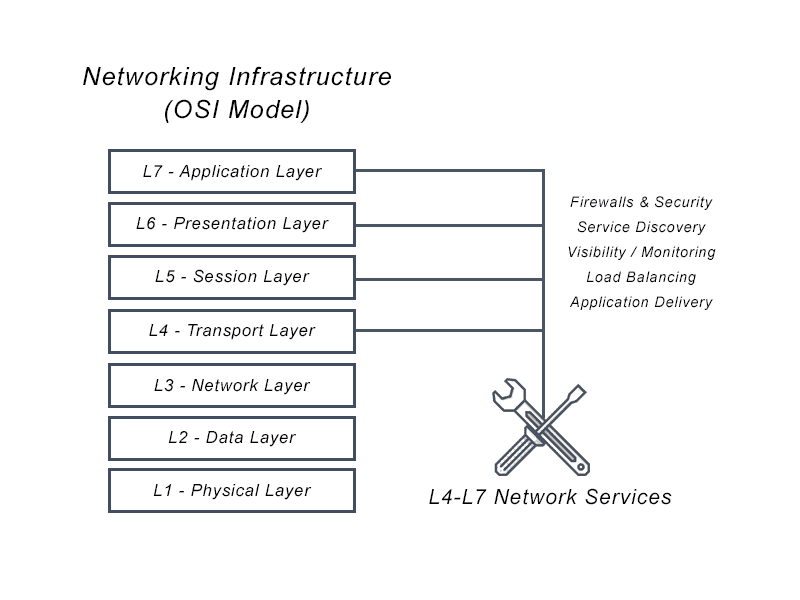L4-L7 Network Services Definition
L4-L7 Network Services Definition are a set of functions such as: load balancing, web application firewalls, service discovery, and monitoring for network layers within the Open Systems Interconnection (OSI) model. The OSI model is a standard for telecommunications and computing systems. Within this communication system there are partitions called abstraction layers. Layers 4 to 7 (L4-L7) are delineated by function:
L4 – the Transport Layer is for transmission of data between points on a network. Example protocols: TCP/UDP.
L5 – the Session Layer is for managing the dialogues between computers. L5 establishes and manages connections between applications.
L6 – the Presentation Layer is responsible for establishing context within the applications, in which different syntax and semantics are present. This layer provides mapping and communication to various applications. Example protocols: SSL/TLS.
L7- the Application Layer is nearest to the end user. The user and the application are directly interacting, communicating with both. Example protocols: HTTP/SIP

What are L4-L7 Service Networks?
L4-L7 service networks are application services running within those OSI layers. L7 service network is at the application layer and helps with the distribution of traffic. The L4 service network is known as a transport layer that includes TCP and UDP. L4-L7 network services provide data storage, manipulation, and communication services.
What is the Difference between L4 and L7 Load Balancing?
L4 load balancing offers traffic management of transactions at the network protocol layer (TCP/UDP). L4 load balancing delivers traffic with limited network information with a load balancing algorithm (i.e. round-robin) and by calculating the best server based on fewest connections and fastest server response times.
L7 load balancing works at the highest level of the OSI model. L7 bases its routing decisions on various characteristics of the HTTP/HTTPS header, the content of the message, the URL type, and information in cookies.
Does Avi Offer L4-L7 Load Balancing?
Yes! Avi offers enterprise-grade L4-L7 load balancing. Avi Networks has built a disruptive platform for L4–L7 application services with a software-centric approach, enabling customers to scale network automation and application delivery across both private and public clouds. Avi Networks offers :
• Fully automated elastic load balancing (L4-L7), SSL offload, DDoS protection, and WAF with central management and control on private clouds, public clouds and SDN solutions (Cisco ACI, Nuage Networks, and Juniper Contrail)
• Consistent feature set and automation across on-premises, in VMware Cloud on AWS, and other Public Clouds (AWS, Microsoft Azure, and Google Cloud Platform)
• Built-in visibility and analytics for real time application performance monitoring, security insights, and network log analytics
For more on the actual implementation of load balancing, security applications and web application firewalls check out our Application Delivery How-To Videos.
For more information on L4-L7 Network Services see the following resources: